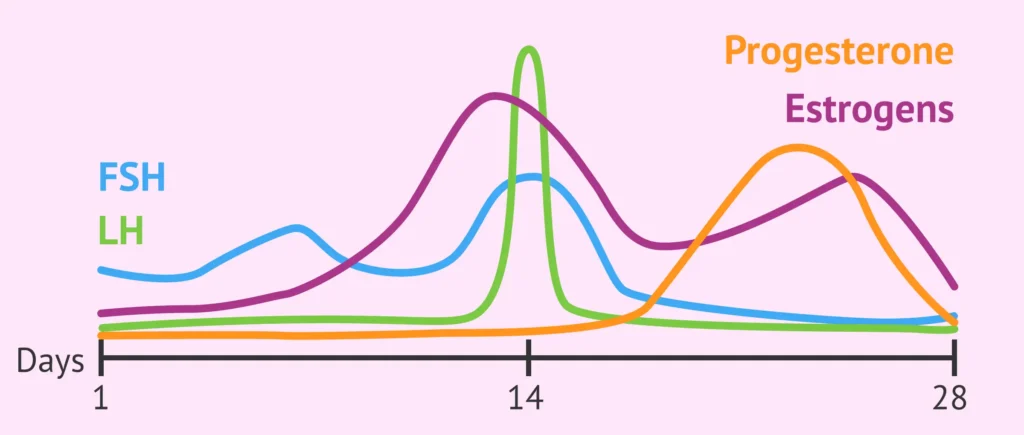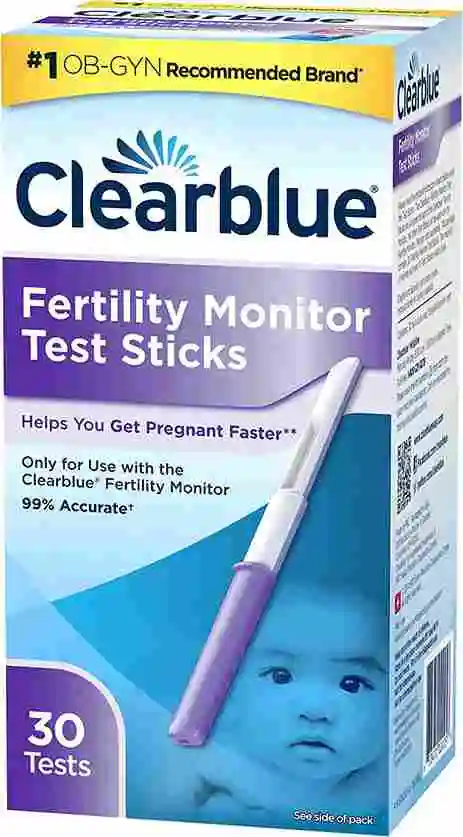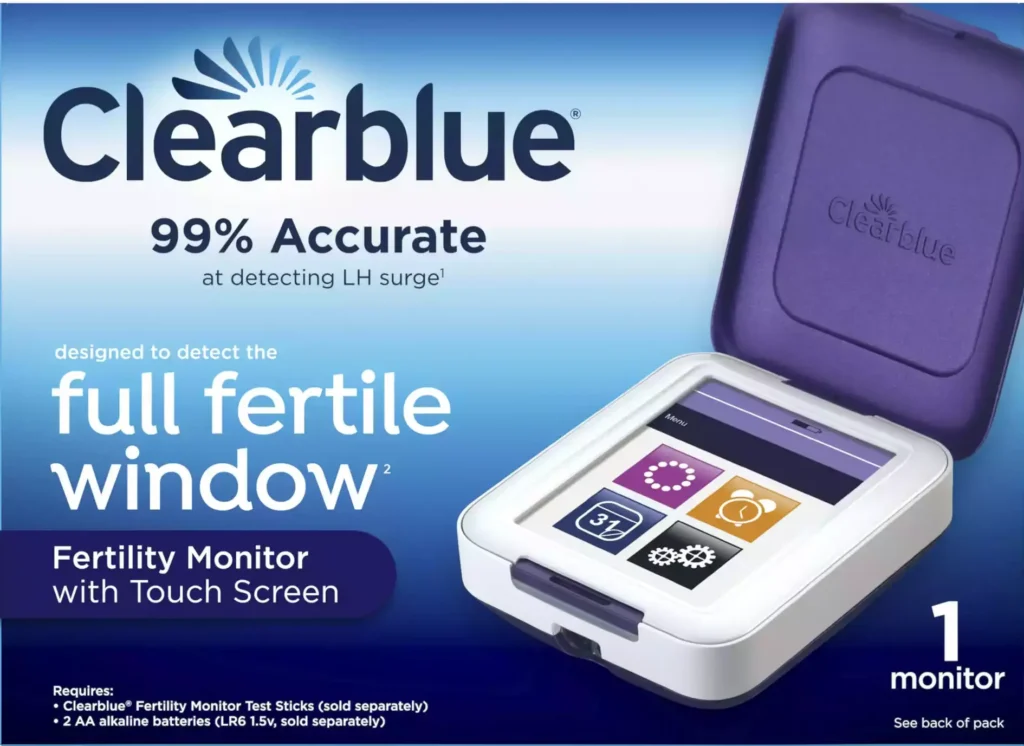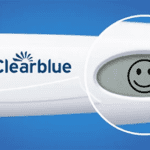If you had told me years ago that I’d be using a fertility monitor to get pregnant, I would have replied, “Why bother? I can get pregnant just by thinking about it!” But as it turns out, my mental powers are not quite as potent as I thought.
When my husband and I decided to have a baby, we quickly realized that it wasn’t going to be as easy as we thought. So we turned to the modern marvel of the Clearblue Fertility Monitor. It’s like having a tiny gynecologist living in your bathroom, analyzing your pee, and giving you the scoop on when you’re most fertile.
Thanks to the Clearblue Fertility Monitor, we were able to make the most of our “quality time” and successfully conceive. And it’s not just for the ladies – my friend’s husband used a similar device to optimize his swimmers and increase their chances of having babies.
So don’t be too quick to dismiss the power of technology when it comes to making babies. After all, the stork is so last century.
Related: Clearblue Ovulation Test
What is Clearblue Fertility Monitor?
We all know that getting pregnant can be a tricky business. There are a variety of factors that come into play, such as age, cycle regularity, and overall reproductive health. That’s where ovulation and fertility monitors come in. But let’s be real, not all monitors are created equal. If you’re new to tracking your cycle, the Clearblue Fertility Monitor Touch Screen is the way to go.
This monitor is specifically designed to make the process as easy and convenient as possible. The touch screen display provides a clear, easy-to-read digital interface that identifies your high and peak fertility days. All you need to do is perform a simple urine test each cycle when prompted, and the monitor does the rest by measuring the levels of estrogen and luteinizing hormone (LH) in your system. It also stores up to six cycles’ worth of history to build a complete picture of your most fertile days.
But what sets the Clearblue Fertility Monitor Touch Screen apart from other monitors is its user-friendliness. The compact, purple and white design resembles a makeup case, making it discreet and easy to carry around. And even though it’s a piece of equipment, it doesn’t feel clunky or awkward. It’s the perfect size to stash on the bathroom counter without adding to the clutter.
So, whether you’re a pro at tracking your cycle or a newbie, the Clearblue Fertility Monitor Touch Screen is the way to go. And who knows, it may just become your new favorite accessory.
How the Clearblue Fertility Monitor Works?
The Clearblue fertility monitor is a handy device for your reproductive health, guiding you through the twists and turns of your menstrual cycle. It measures two key hormones, estrogen and luteinizing hormone (LH), to track your fertility levels. When you’re just starting your cycle, your estrogen and LH levels are low, so the monitor will give you a “low” fertility reading. But as your estrogen levels start to climb, the monitor will return a “high” fertility reading. And when you hit the jackpot and the monitor detects an LH surge, you’ll get a “peak” reading, which means you’re at the height of your fertility for that cycle and are likely to ovulate in the next few days.
The monitor won’t ask for a test during the first five days of your cycle, since research shows that those days are usually infertile. And once the monitor detects an estrogen rise, it will keep displaying “high” readings until it either detects an LH surge or reaches cycle day 25, which is when most women will ovulate. Finally, the monitor will ask for a maximum of 20 tests per cycle, assuming that if it hasn’t identified an LH surge by that point, it probably missed it.
Normal LH, Estrogen, and Progesterone Levels During One Menstrual Cycle

The slow rise in estrogen levels (purple) in the figure above precedes the LH spike (green). Only the Clearblue monitor can detect an increase in estrogen and the start of heightened fertility.
What is the Significance of This?
It’s just basic biology.
While an egg only lives 12 to 24 hours, sperm may live in the woman’s body for 3-5 days as long as estrogen levels are high. Utilizing a Clearblue Monitor can help you identify a longer fertile window than other monitors or LH test sticks, giving you a higher chance of having viable sperm present when ovulation happens.
Related: How to Get Pregnant Faster?
Typical Progression of Monitor Readings During One Menstrual Cycle
| Cycle Day | Fertility Result | Cycle Day | Fertility Result |
| 1 | X | 10 | High |
| 2 | X | 11 | High |
| 3 | X | 12 | High |
| 4 | X | 13 | Peak |
| 5 | X | 14 | Peak |
| 6 | Low | 15 | High |
| 7 | Low | 16 | Low |
| 8 | Low | 17 | Low |
| 9 | High | 18 | Low… |
How to Use Clearblue Fertility Monitor?
Before You Begin
- Set up the monitor and then wait for your next menstrual cycle to begin before setting a new cycle and your testing window. Your testing window is the 6 hour period during which you can do a test. It should be set so it’s convenient for you to test the first urine of the day. You only need to test when requested by the monitor.
- Always start your cycle with enough test sticks from the same lot for at least 10 tests (you will find the lot number on both the outer and inner packaging).
- Only use each test stick once and never after the expiry date stated.
- Only test when the monitor shows the test day screen and always within your testing window.
PerformingTests
- Switch on your Clearblue Fertility Monitor every morning within your testing window to check if you should do a test.
- In cycle 1 your first test will be requested on day 6. The monitor will then request a test for a total of 10 or 20 days. In subsequent cycles the first test days will vary between day 6 and 9. You will still be asked to test every day for 10 or 20 days.
- You must always use the first urine after your longest sleep.
- Choose your method of testing –
- Dipping: Collect a sample of urine in a clean, dry container. Remove the test stick from the foil and use immediately. Put the sampling end in the urine for 15 seconds.
- In your urine stream: Hold the sampling end pointing downwards in your urine stream for 3 seconds.
- Keeping the test stick pointing downwards, take the cap off the handle and place it over the ‘wet’ end of the test stick. Wipe off any excess urine.
- Do not hold the test stick with the sampling end pointing upwards as the result may be affected.
- Immediately insert the test stick, as shown. Make sure the monitor is switched on and wait for the Clearblue screen to disappear before inserting the test stick.
Wait for 5 Minutes
– The monitor will confirm the test stick is inserted correctly and a countdown screen will appear.
– Wait 5 minutes for your result. The screen will switch off after 1 minute, but the monitor will continue to analyze the test.
– Once testing has finished, the alarm will sound and the light will stop flashing.
– If the monitor is off, switch it back on and remove the test stick. Your fertility status will then be displayed. Throw the test stick away. Never reuse a test.
Read Your Results
- Low Fertility: Very small chance of conception.
- High High Fertility: Increased chance of conception.
- Peak Peak Fertility: Highest chance of conception.
If you have sex during peak fertility, you have the greatest chance of becoming pregnant.
Peak fertility will be displayed for 2 consecutive days.
Approaching the End of Your Cycle
- Usually a few days before your next period is due a flashing symbol will appear indicating you are approaching the end of your cycle. If your period starts set your monitor for the next cycle.
- If the symbol flashes for several days and you think your period is late, then you may be pregnant. You can find out using a Clearblue Pregnancy Test.
How Accurate is Clearblue Fertility Monitor?
Most over-the-counter ovulation tests monitor only the luteinizing hormone, but the Clearblue Fertility Monitor with touch screen tracks both LH and estrogen hormones. Laboratory tests prove, that the monitor is 99% accurate at detecting the LH surge, which means you’re ovulating. When used to achieve a pregnancy, it increases the odds of achieving a pregnancy by 89% in the first month of attempting. The Clearblue Fertility Monitor adjusts to your fertility trends over time and has you test based on your specific results, which means the days you test will change over time depending on your cycles. While the fertility sticks cost $39.88 each box, you’ll only need about 10 sticks to test your fertility each cycle, so you may use one box every three cycles.
Why We Like Clearblue Fertility Monitor
With this handy touch-screen digital monitor, everything you need to analyze your test strips and understand the results is at your fingertips.
The majority of the specialists we spoke to agreed that the most reliable and accurate approach to checking for ovulation is using test strips that look for luteinizing hormone (LH) in your urine. However, there are a variety of techniques to analyze your urine sample and obtain the necessary information. The advantage of a digital monitor is that it can read test strips and help you understand your results. Both users and experts appreciate the Clearblue Fertility Monitor.
We like that the gadget has a sizable touch screen that is simple to use and displays your odds of getting pregnant right there. (Because the Clearblue Fertility Monitor doesn’t require an internet connection like some other gadgets, it’s great for traveling.) It is also simpler to use if you can’t recall when you last tested or when your next test is due because the gadget also displays your testing window.
Important Note: Since test strips are not included in the price, you must budget separately for them.
Product Details
Type: Digital monitor (battery powered)
What’s Included: One digital monitor and English Instruction Booklet (test strips not included)
Tracks: Estrogen, luteinizing hormone
App: No
FDA-approved: No
Pros
- Easy to use
- Accurate for fertility prediction
- Stores 6 cycles of data
- Touch screen monitor
Cons
- Not ideal for long or irregular cycles
- Test strips sold separately
- Learning curve with strips
- Expensive
Amazon Customer Reviews: 4.4 out of 5
1.) My husband and I had been trying to get pregnant for a year with no luck. I used the Clearblue monitor to track my ovulation and got pregnant that month! I highly recommend this for anyone trying. We were getting worried something was wrong and our doctor wanted to test for PCOS but recommended trying this method first and I’m so happy he did!
2.) Im 37 years old and my husband and I started trying about 5 months ago. My ovulation has always been weird and i thought i might be trying at the wrong time. We’ll this is the first month I tried and we’re pregnant! He also had issues with his fertility and even still knowing our peak days it worked. We only tried these 2 days and thank you God we’re pregnant!
Clearblue Fertility Monitor, Touch Screen, 1 Count

99% Accurate
- Proven to increase the chances of getting pregnant by 82%.
- Detects more fertile days than traditional ovulation tests.
- Easy to use touch screen monitor.
- Stores up to 6 cycles of your personal information.
- 99% accurate at detecting the LH surge
Clearblue Fertility Monitor Test Sticks, 30 Count

Help You Get Pregnant Faster
- Only for use with Clearblue Fertility Monitor
- 30 Individually Wrapped Test Sticks
- Suitable for Women with Cycles 21-42 Days Long
- Majority of Women will Need 10 Test Sticks Each Cycle
- Women with Irregular or Long Cycles may have to use 20 Test Sticks Each Cycle
- Compatible with Fertility Monitor with Touch Screen and Fertility Monitor without Touch Screen
Frequently Asked Questions
Can Clearblue Fertility Monitor Miss LH Surge?
In laboratory testing, the Clearblue Fertility Monitor was demonstrated to be 99% accurate in detecting the LH surge in cycles when an LH surge was verified to be present.
How Much hCG does Clearblue Fertility Monitor Detect?
According to published research, hCG levels should be at least 50 milli-International Units per milliliter (mIU/ml) on the day a pregnant woman’s period is due. When taken on the day of the expected period, a Clearblue Pregnancy Test is more than 99% reliable in identifying pregnancy.
How Long After Smiley Face Do You Ovulate?
Ovulation normally occurs 24 to 36 hours following the spike in luteinizing hormone (LH) in the majority of healthy women. When ovulation is finished, LH levels return to where they were previous to ovulation (read about early ovulation here).
How Many Days Before Peak is High Ovulation?
High fertility lasts from five days before ovulation until peak fertility begins.
Is hCG Higher in the Morning or at Night?
HCG levels are highest in the morning, when urine is fresh and not diluted by liquids consumed during the day. If you test in the afternoon, your urine may be depleted of hCG.
How Often is Clearblue Fertility Monitor a False Positive?
False positive findings are extremely uncommon because hCG is often only present in your body when you are pregnant. If you use an accurate pregnancy test, like Clearblue, and the result is positive, you may be over 99% certain that you are pregnant.
How Do I Know Ovulation is Over?
About 6 to 8 days following your estimated day of ovulation, you can test for progesterone to determine whether ovulation has ended. Your progesterone levels will be at their greatest during this time, and rising progesterone levels indicate a successful ovulation.
What is the Most Accurate Fertility Monitor?
The Clearblue Fertility Monitor which monitors luteinizing hormone surge with a 99 percent accuracy is the most accurate fertility monitor. Prior to ovulation, the monitor displays your two peak fertility days and high fertility days. It informs you of the days on which you must test, which entails placing a urine test wand into the monitor.
When Should I Start Using the Clearblue Fertility Monitor?
The Clearblue Fertility Monitor can be used on the first day of your next cycle (Day 1 of your period), but not before. When you receive your period, you’ll need to start a fresh cycle.
Related: 10 Best At-Home Fertility Tests in 2023













